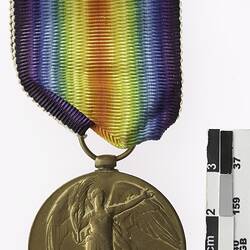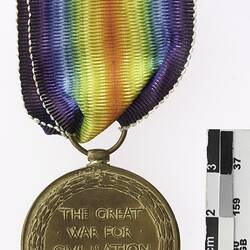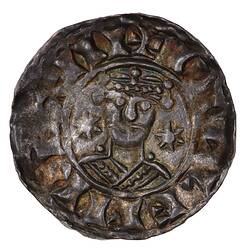Summary
Victory Medal 1914-1919 with ring mount and ribbon awarded to Private Aubrey Gordon Neal, service number 106, 8th L.H. R. (Light Horse Regiment), A.I.F.
Private Neal was a labourer in Collingwood when he joined on 10 September 1914, aged 21 years and 2 months. Whilst in Gallipoli he suffered from tonsillitis so was taken to Malta. He returned to Gallipoli where he got trench foot and then later in 1916, records show he had diphtheria. Private Neal returned to Australia in January 1919.
The Victory Medal was authorised in 1919 and was awarded to army, navy and air force personnel who served in a theatre of war between midnight 4th-5th August 1914 and midnight 11th-12th November 1918. The Allies resolved that, if they wished to issue a Victory Medal, it would share a common feature of a depiction of Victory on the obverse and a ribbon of red, yellow, green, blue and violet merged into a rainbow pattern. This medal, that of Great Britain, was awarded to personnel from countries in the British Empire (some 5,725,000 were issued). The other Allied countries that issued Victory medals were: Belgium, Brazil, Cuba, Czechoslovakia, France, Greece, Italy, Japan, Portugal, Romania, Thailand, Union of South Africa and the United States of America.
Obverse Description
Figure of Victory facing three-quarters right with wings spread; in her right hand she holds a palm branch, her left hand is extended and open. The artist's initials, W.McM. (W. McMillan) are above the ground line on the right.
Reverse Description
The words, 'THE GREAT . WAR FOR . CIVILISATION 1914-1919' within a circular wreath of laurel.
Edge Description
Text; '106 PTE. A.G. NEAL 8 L.H. R. A.I.F.'.
More Information
-
Collecting Areas
-
Date Issued
1919 AD
-
Issued By
-
Mint
-
Artist
-
Awarded To
Private Aubrey Gordon Neal, Australia, 1919
106 Pte A.G. Neal, 8th Light Horse, A.I.F. -
Place
Gallipoli Peninsula, Turkey, 1915
Place medal recepient served -
Inscriptions
Obverse; 'W.McM.' (W. McMillan- artist). Reverse; 'THE GREAT . WAR FOR . CIVILISATION 1914 - 1919'. Edge; '106 PTE. A.G. NEAL 8 L.H. R. A.I.F.'.
-
Material
Bronze
-
Axis
12
-
Classification
-
Category
-
Discipline
-
Type of item
-
Overall Dimensions
50 mm (Height), 36 mm (Outside Diameter)
Height to top of ring.
-
Shape
Round with loop and ribbon
-
References
References: records [Link 1] War I/World War I.html.
-
Keywords







